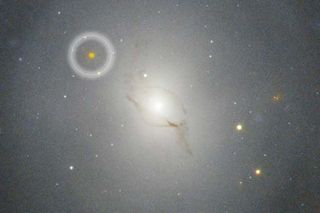When Neutron Stars Collide! What the Hubble Telescope and Others Saw (Videos)

On Aug. 17, 2017, gravitational waves from a neutron-star collision were detected for the first time ever by LIGO and Virgo collaborations and - in another first - light from the event has been captured by observatories in space and on Earth. The source has been designated GW170817 and is described as a "kilonova" event.
Gravitational Waves Detected from Neutron-Star Crashes: The Discovery Explained
See videos of the event as it appeared through the lenses of the Hubble Space Telecope, Chandra X-ray Observatory, Gemini Observatory and more.
Hubble Space Telescope observes source of gravitational waves
The Hubble Space Telescope operated by NASA and the European Space Agency captured imagery of the source of the gravitational waves detection. Learn more about it from the Hubblecast video:
'Kilonova' from neutron star merger observed by multiple ESO telescopes
Several European Southern Observatory telescopes in Chile's Atacama Desert were used to discover the "kilonova," the merging of the neutron stars. Learn more about it in this ESOCast video:
Get the Space.com Newsletter
Breaking space news, the latest updates on rocket launches, skywatching events and more!
Chandra X-ray Observatory's first detection of GW170817
Scientists with the Chandra X-ray Observatory, a space-based telescope, explain the first X-ray detection of gravitational waves source in this tour of the event's location in space:
Gemini Observatory, Swope and Megellan Telescopes imagery
Theoretical astrophysicist Daniel Kasen at the University of California, Berkeley, describes how the neutron star collision was discovered and what its debris is comprised of:
Observations from CSIRO Telescope in Australia
University of Sydney associate professor Tara Murphy talks about hearing about the gravitational waves detection of the neutron star merger and the CSIRO telescope observations:
Follow Steve Spaleta on Twitter or Facebook. Follow us @Spacedotcom, Facebook and Google+. Original article on Space.com.
Join our Space Forums to keep talking space on the latest missions, night sky and more! And if you have a news tip, correction or comment, let us know at: community@space.com.

Steve Spaleta is Space.com's Senior Producer. Since 2007, Steve has produced and edited space, science and entertainment-related videos for Space.com. He is also the producer/writer/editor of Space.com's CosMix series on space-enthused artists. He studied psychology at the State University of New York at Stony Brook and is originally from Zadar, Croatia by way of Astoria, NY. To see Steve's latest project, follow him on Twitter and follow Space.com's VideoFromSpace YouTube Channel.
